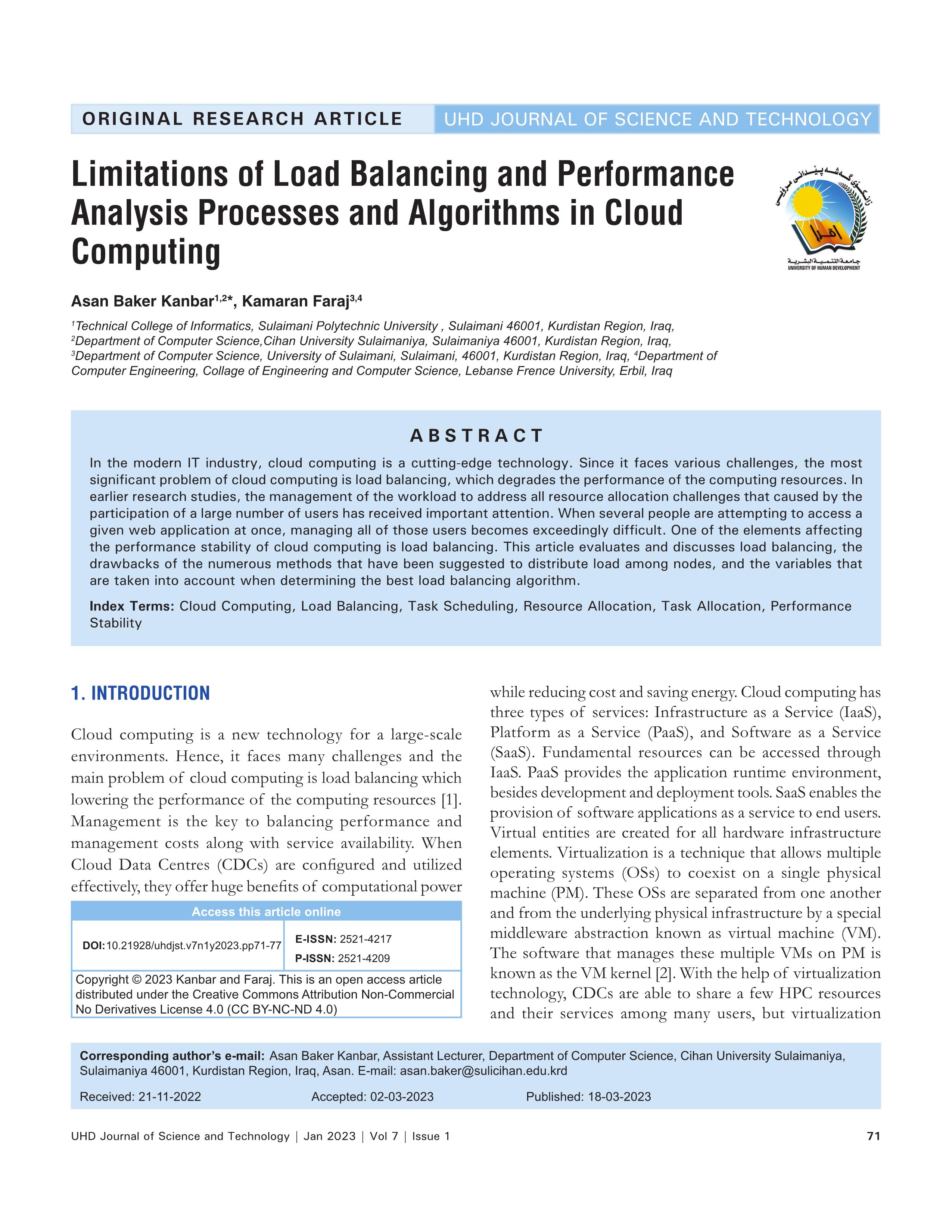Limitations of Load Balancing and Performance Analysis Processes and Algorithms in Cloud Computing
DOI:
https://doi.org/10.21928/uhdjst.v7n1y2023.pp71-77Keywords:
Cloud Computing, Load Balancing, Task Scheduling, Resource Allocation, Task Allocation, Performance StabilityAbstract
In the modern IT industry, cloud computing is a cutting-edge technology. Since it faces various challenges, the most significant problem of cloud computing is load balancing, which degrades the performance of the computing resources. In earlier research studies, the management of the workload to address all resource allocation challenges that caused by the participation of a large number of users has received important attention. When several people are attempting to access a given web application at once, managing all of those users becomes exceedingly difficult. One of the elements affecting the performance stability of cloud computing is load balancing. This article evaluates and discusses load balancing, the drawbacks of the numerous methods that have been suggested to distribute load among nodes, and the variables that are taken into account when determining the best load balancing algorithm.
References
A. B. Kanbar and K Faraj. “Regional aware dynamic task scheduling and resource virtualization for load balancing in IoT-Fog multi-cloud environment”. Future Generation Computer Systems, 137C, pp. 70-86, 2022.
H. Nashaat, N. Ashry and R. Rizk. “Smart elastic scheduling algorithm for virtual machine migration in cloud computing”. The Journal of Supercomputing, vol. 75, pp. 3842-3865, 2019.
H. Gao, H. Miao, L. Liu, J. Kai and K. Zhao. “Automated quantitative verification for service-based system design: A visualization transform tool perspective”. International Journal of Software Engineering and Knowledge Engineering, vol. 28, no. 10, pp. 1369- 1397, 2018.
S. V. Pius and T. S. Shilpa. “Survey on load balancing in cloud computing”. In: International Conference on Computing, Communication and Energy Systems, 2014.
P. Jain and S. Choudhary. “A review of load balancing and its challenges in cloud computing”. International Journal of Innovative Research in Computer and Communication Engineering, vol. 5, no. 4, pp. 9275-9281, 2017.
P. Kumar and R. Kumar. “Issues and challenges of load balancing techniques in cloud Computing: A survey”. ACM Computing Surveys, vol. 51, no. 6, pp. 1-35, 2019.
M. Alam and Z. A. Khan. “Issues and challenges of load balancing algorithm in cloud computing environment”. Indian Journal of Science and Technology, vol. 10, no. 25, pp. 1-12, 2017.
H. Kaur and K. Kaur. “Load Balancing and its Challenges in Cloud Computing: A Review”. In: M. S. Kaiser, J. Xie and V. S. Rathore, editors. Information and Communication Technology for Competitive Strategies (ICTCS 2020). Lecture Notes in Networks and Systems, vol. 190. Springer, Singapore, 2021.
G. K. Sriram. “Challenges of cloud compute load balancing algorithms”. International Research Journal of Modernization in Engineering Technology and Science, vol. 4, no. 1, p. 6, 2022.
H. Chen, F. Wang, N. Helian and G. Akanmu. “User-priority Guided Min-min Scheduling Algorithm for Load Balancing in Cloud Computing”. In: Proceeding National Conference on Parallel Computing Technologies (PARCOMPTECH), IEEE. pp. 1-8, 2013.
A. F. Devaraj, M. Elhoseny, S. Dhanasekaran, E. L Lydia and K. Shankar. “Hybridization of firefly and improved multi-objective particle swarm optimization algorithm for energy efficient load balancing in cloud computing environments”. Journal of Parallel and Distributed Computing, vol. 142, pp. 36-45, 2020.
M. M. Maswood, M. R. Rahman, A. G. Alharbi and D. Medhi. “A novel strategy to achieve bandwidth cost reduction and load balancing in a cooperative three-layer fog-cloud computing environment”. IEEE Access, vol. 8, pp. 113737-113750, 2020.
H. Sun, H. Yu, G. Fan and L. Chen. “Energy and time efficient task offloading and resource allocation on the generic IoT-fog-cloud architecture”. Peer-to-Peer Networking and Applications, vol. 13, no. 2, pp. 548-563, 2020.
L. Yu, L. Chen, Z. Cai, H. Shen, Y. Liang and Y. Pan. “Stochastic load balancing for virtual resource management in datacenters”. IEEE Transactions on Cloud Computing, vol. 8, pp. 459-472, 2020.
Z. Miao, P. Yong, Y. Mei, Y. Quanjun and X. Xu. “A discrete PSO-based static load balancing algorithm for distributed simulations in a cloud environment”. Future Generation Computer Systems, vol. 115, no. 3, pp. 497-516, 2021.
D. Singh, P. S. Saikrishna, R. Pasumarthy and D. Krishnamurthy. “Decentralized LPV-MPC controller with heuristic load balancing for a private cloud hosted application”. Control Engineering Practice, vol. 100, no. 4, p. 104438, 2020.
N. M. Donnell, E. Howley and J. Duggan. “Dynamic virtual machine consolidation using a multi-agent system to optimise energy efficiency in cloud computing”. Future Generation Computer Systems, vol. 108, pp. 288-301, 2020.
F. Hosseini, A. Safari and M. Farrokhifar. “Cloud theory-based multi-objective feeder reconfiguration problem considering wind power uncertainty”. Renewable Energy, vol. 161, pp. 1130-1139, 2020.
M. Kumar, S. C. Sharma, S. S. Goel, S. K. Mishra and A. Husain. “Autonomic cloud resource provisioning and scheduling using meta-heuristic algorithm”. Neural Computing and Applications, vol. 32, pp. 18285-18303, 2020.
M. Kumar, A. Kishor, J. Abawajy, P. Agarwal, A. Singh and A. Y. Zomaya. “ARPS: An autonomic resource provisioning and scheduling framework for cloud platforms”. IEEE Transactions on Sustainable Computing, vol. 7, no. 2, pp. 386-399, 2021.
X. Liu, B. Cheng and S. Wang. “Availability-aware and energy-efficient virtual cluster allocation based on multi-objective optimization in cloud datacenters”. IEEE Transactions on Network and Service Management, vol. 17, no. 2, pp. 972-985, 2020.
A. B. Kanbar and K. Faraj. “Modern load balancing techniques and their effects on cloud computing”. Journal of Hunan University (Natural Sciences), vol. 49, no.7, pp. 37-43, 2022.

Downloads
Published
How to Cite
Issue
Section
License
Copyright (c) 2023 Asan Baker Kanbar, Kamaran Faraj

This work is licensed under a Creative Commons Attribution-NonCommercial-NoDerivatives 4.0 International License.


